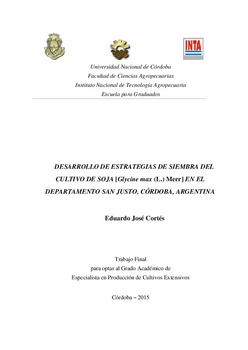| dc.contributor.advisor | Villar Ezcurra, Jorge | |
| dc.contributor.author | Cortés, Eduardo José | |
| dc.date.accessioned | 2016-03-29T16:28:22Z | |
| dc.date.available | 2016-03-29T16:28:22Z | |
| dc.date.issued | 2015 | |
| dc.identifier.uri | http://hdl.handle.net/11086/2530 | |
| dc.description | Trabajo Final (Especialización en Producción de Cultivos Extensivos)--UNC- Facultad de Ciencias Agropecuarias, 2015 | es |
| dc.description.abstract | Uno de los pilares más importantes para obtener buenos rendimientos en el cultivo de soja es combinar los grupos de madurez (GM) con fechas de siembra (FS) que permitan ubicar las etapas críticas en momentos de alta calidad ambiental en términos de adecuada radiación solar, temperatura y condición hídrica. El objetivo del trabajo fue determinar la respuesta del rendimiento de diferentes grupos de madurez de soja ante la modificación de la fecha de siembra.
El ensayo se realizó durante la campaña 2010-2011 en dos localidades de la zona este de la provincia de Córdoba (Luxardo y Freyre), y consistió en la siembra de genotipos de GM IV, V, VI y VII en cinco fechas de siembra (octubre a diciembre). Se utilizó un diseño de parcelas sub-sub-divididas con tres repeticiones. La parcela principal fue la localidad y la fecha de siembra y el GM fueron la sub y sub-parcela respectivamente. Se evaluaron variables morfométricas descriptoras del crecimiento (altura y número de nudos), el rendimiento en grano y sus componentes; número de vainas, de granos (NG) y peso individual de granos (PG).
Para todas las variables analizadas, tanto los factores principales como las interacciones entre ellos fueron significativas por lo que tanto el ambiente, como la selección del GM y la fecha de siembra deben ser tenidos en cuenta simultáneamente para maximizar los rendimientos alcanzables. Los ambientes difirieron en calidad (Luxardo>Freyre), principalmente en términos de agua útil en suelo a la siembra. En Luxardo, los GM IV y V fueron superiores a los demás, mientras que en Freyre (con mayores restricciones ambientales), los GM V y VI fueron los mejor adaptados. En términos medios, los GM V exhibieron altos rendimientos en ambos ambientes, aspecto que los convierte en una buena elección cuando la calidad ambiental destinada a la siembra es incierta. Los grupos de madurez VII, por el contrario siempre exhibieron menores rendimientos en ambos ambientes, particularmente en fechas más tardías. El número de granos fue el componente de rendimiento que explicó prioritariamente la variación del rendimiento a través de tratamientos. El PG en el GM VII explicó adicionalmente el rendimiento y siempre fue el más bajo entre las distinta combinaciones GM*FS. | es |
| dc.description.abstract | The most important pillars for obtaining high yields in soybean is to adequately combine maturity groups (GM) and planting dates (FS) in order to establish the critical period for yield determination during moments of high environmental quality in terms of solar radiation, temperature and moisture conditions. The objective of this work was to determine the yield response of different soybean maturity groups grown under different planting dates.
The trial was conducted during the 2010-2011 season at two locations in the eastern of the province of Córdoba (Luxardo and Freyre), and consisted of planting genotypes maturity groups IV, V, VI and VII on five sowing dates (October to December). A Split-split-plot design with three replications was used. The main plot was the site and the planting date maturity group were the sub and sub-subplot. Morphometric variables descriptive of growth (plant height and number of nodes), grain yield and its components, number of pods per plant and grain number per unit area and individual grain weight were determined.
For most of the variables, both main factors (locations, maturity group and sowing date) and their interactions were significant, indicating that GM selection and planting date should be considered simultaneously to maximize attainable yields. Environments differed in quality (Luxardo> Freyre), mainly in terms of available soil water at planting. In Luxardo, GM IV and V were superior to others, while at Freyre (with higher environmental restrictions), GM V and VI were the best adapted. On average, GM V exhibited high yields in both environments, and so, genotypes within this GM seem to be a good choice when environmental quality for sowing is unknown. Maturity group VII always exhibited the lowest yields in both environments particularly at later dates. Grain number was the yield component that primarily explained grain yield variation across treatments. PG in GM VII also explained yield variation and was lowest among the different GM*FS combinations. | en |
| dc.format.extent | 42 h. : tablas, gráficos color | |
| dc.language.iso | spa | es |
| dc.rights | Atribución-NoComercial-SinDerivadas 2.5 Argentina | * |
| dc.rights.uri | http://creativecommons.org/licenses/by-nc-nd/2.5/ar/ | * |
| dc.subject | Soja | es |
| dc.subject | Siembra | es |
| dc.subject | Rendimiento de cultivos | es |
| dc.subject | Fecha de siembra | es |
| dc.subject | Madurez | es |
| dc.subject | Departamento San Justo | es |
| dc.subject | Córdoba | es |
| dc.subject | Argentina | es |
| dc.title | Desarrollo de estrategias de siembra del cultivo de soja [Glycine max (L.) Merr] en el departamento San Justo, Córdoba, Argentina | es |
| dc.type | masterThesis | es |





